



Note on Image: Sgt. 1st Class Lance Amsden, platoon sergeant for the 1st Platoon, Company C, 1st Battalion, 501st Infantry Regiment, 4th Brigade Combat Team (Airborne), 25th Infantry Division, watches as CH-47 Chinook helicopters circle above during a dust storm at Forward Operating Base Kushamond, Afghanistan, during preparation for an air assault mission. Note on Authors: Laura J. Steinberg, Ph.D. Dean, LC Smith College of Engineering and Computer Science Syracuse University 223 Link Hall Syracuse, NY 13244-1240 315-443-4341(phone) 315-443-4936 (fax) ljs@syr.edu Corri Zoli, Ph.D. Assistant Research Professor Institute for National Security and Counterterrorism (INSCT) Maxwell School of Citizenship and Public Affairs Syracuse University College of Law 541F White Hall Syracuse University, Syracuse, NY 13244-1030 (tel) 315.443.4523 | (fax) 315.443.9643 cbzoli@syr.edu Nicholas J. Armstrong National Security Research Fellow Institute for National Security and Counterterrorism (INSCT) Maxwell School of Citizenship and Public Affairs Syracuse University College of Law 402 MacNaughton Hall Syracuse University, Syracuse, NY 13244 (p) 315-443-2033 | (f) 315-443-9643 narmstro@maxwell.syr.edu Note on the Report: This Report is a DRAFT of preliminary findings. Please contact the authors if you wish to reproduce or disseminate this material: citation is permissible, so long as it is noted that the work cited is a draft of research findings.
Contents 1.0 Project Background and Overview ………………………………………………………………………… ....1 1.1 Five Initial Assumptions…………………………………………………………………………………………………..1 1.2 Post-9/11 Veterans Educational Assistance Act of 2008……………………………………………………… .2 1.3 Veterans “By the Numbers”: Implications for Higher Education and Engineering…………………… ..3 1.4 Why is this Research Important? Lessons Learned from the Original 1944 GI Bill …………………….. 4 2.0 Study Design and Approach ……………………………………………………………………………………. 6 2.1 Interdisciplinary Research Team ……………………………………………………………………………………… 6 2.2 Existing Studies and Research Literature ………………………………………………………………………… ...7 2.3 Veteran’s Education and Engineering: Research Questions ………………………………………………… ..9 2.4 Coordinated Dat a Collection and Mixed Methods………………………………………………………………. 9 3.0 Preliminary Findings: Five Broad Categories ……………………………………………………………… 11 3.1 Engineering Aspirations and Military Servicepersons as Postsecondary Students: The ‘Bad News’……………………………………………………………………………………………………………………….. 11 3.2 Veteran Student Needs and Supports in the Academic Environment: Veteran Recommendations ……………………………………………………………………………………………………….12 3.3 Military Culture and Traits: Predictors of Academic Needs and Success?.....................................13 3.4 Pathways: Educational and Career ………………………………………………………………………………….1 3 4.0 Recommendations: Future Directions In Research & Questions We Are Left With ……………… 14 4.1 How to Contend with Barriers for Veterans in the Postsecondary Education and Engineering Contexts?....................................................................................................................................14 4.2 Some Potential Problems: A Daunting Amount of Work for Universities?....................................14 4.3 Additional Research Needed/Future Questions …………………………………………………………………15 5.0 Summary Discussion Points and Findings ………………………………………………………………….1 6 5.1 National Science Foundation Veterans’ Education in Science and Engineering Meeting Presentation Slides , Washington, DC (15 March 2011) : Appendix A….……………………………………………………..16
5.2 “Success Stories”: Establishing a Compendium of Advice for Integrating Veterans into Higher Education………………………………………….………………………………………………………………………..16 5.3 Outreach/Recruitment: Defining a New Approach to Veterans Education ……………………………..1 7 5.4 Veterans as Student: Respectfully Identifying Needs …………………………………………………………17 5.5 Evaluation Strategies: Evaluating the Evaluators ……………………………………………………………… 19
1.0 PROJECT BACKGROUND AND OVERVIEW In this section, we provide background, premises, and aggregate results from our ongoing data collection efforts, supported by the National Science Foundation Support (NSF), begun in September 2009. Our data comprises active duty servicemembers and veterans in their educational aspirations, including their intentions to use their Post-9/11 GI Bill (and Yellow Ribbon Program) educational benefit, particularly with respect to the fields of science, technology, engineering, and mathematics (STEM). Our work was initially framed from the point of view of higher educational institutions and the needs of decision-makers, such as university engineering deans, to estimate and plan for the projected 2-3 million veterans to use their Post-9/11 GI Bill benefits in the years following the bill’s implementation. After initial discussions, we quickly realized the scarcity of data on servicepersons’ educational aspirations and intentions, and, thus, the critical importance of thinking about higher education from the point of view of servicemembers themselves. We also discovered, given the often limited interest in pursuing degrees in engineering and the STEM fields more generally, that a more holistic approach to higher education and what it means to servicemembers was in order. Our research results thus reflect the continuing evolution and refinement of our research questions. 1.1 Five Initial Assumptions: Our research began with five initial assumptions, many of which still hold after two years of research: 1 First, women and men of the U.S. armed forces, once they leave the services, are a potential critical resource for U.S. technical capacity in the private sector but also in government. Many servicepersons have been immersed in technical activities in their military jobs, possess an abundance of technical training, have familiarity with cutting-edge technologies and equipment, and, thus, have the potential to form the backbone of U.S. engineering and technology innovation in the near future. Second, the unprecedented diversity of the U.S. armed forces offers the potential for an amazingly diverse pipeline for higher education institutions in general and for engineering in particular . Third, universities are currently at a critical juncture in which newly expanded veterans’ benefits enables higher education to serve those who have served and for both parties — universities and veterans — to gain valuable experiences from the presence of veterans on campus made possible by the new GI Bill . 1 One of the first conversations about this critical need area occurred in 2009 with a working group called together by the Division of Engineering Education and Centers of NSF to discuss the ramifications of the Post 9/11 GI Bill for Engineering Education. The group reached a number of conclusions: (1.) Recognize the need for special pathways for veterans in STEM; (2.) NSF recommended a $100 million program to support these pathways and include year-round programming, establishing specialized support services, and industry-university partnerships; (3.) Data collection and interpretation is needed to insure that funding for these activities is correctly targeted, including data on the number of GIs likely to undertake STEM education. See National Science Foundation (2009), Veterans’ Education for Engineering and Science: Report of the National Science Foundation Workshop on Enhancing the Post 9/11 Veterans Educational Benefit , McLean, VA (13 April 2009). 1
Recommend
More recommend